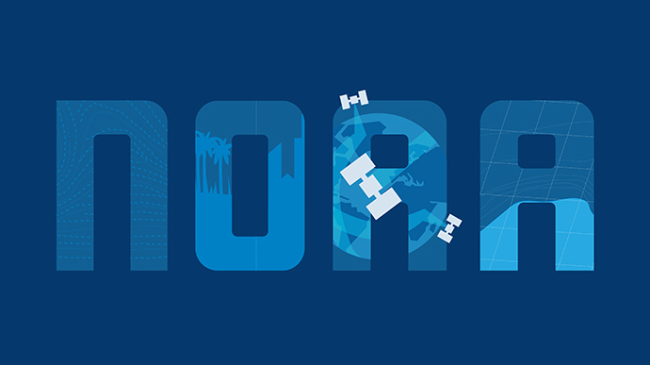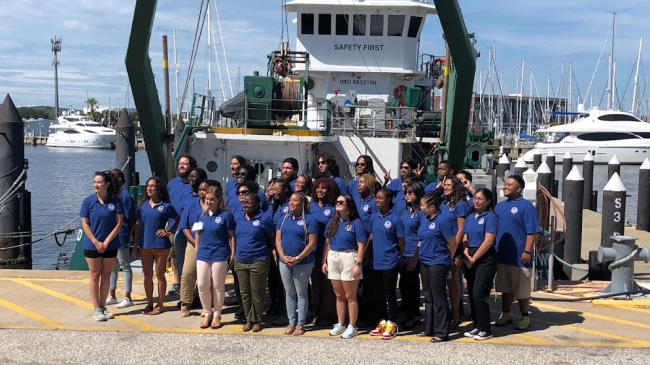The mission of NOAA EPP/MSI Center for Earth System Sciences and Remote Sensing Technologies (CESSRST-II) is to train, educate, and graduate a cadre of diverse and highly competitive students, especially with a focus on those from traditionally underrepresented communities, in NOAA mission-aligned disciplines. Disciplines that CESSRST II fellows study range broadly, from Earth and environmental science to ecology, physics, engineering, and social sciences.
CESSRST II students and staff attended the 2022 EPP/MSI Educational Partnership Program with Minority Serving Institutions Education and Science Forum where they shared and discussed their research. The forum was hosted by Florida Agricultural and Mechanical University, the lead institution for the Center for Coastal and Marine Ecosystems, a NOAA Cooperative Science Center. (Image credit: Courtesy of Florida Agricultural and Mechanical University.)
CESSRST II takes a multifaceted approach to training well-rounded STEM professionals, which includes:
- Rigorous coursework
- Technical and professional workshops
- Hands-on participation in state of the art collaborative NOAA mission-aligned research projects
- Direct engagement with NOAA scientists through mentorship and professional meetings.
In the following sections, we highlight a few examples of these education and training opportunities.
CESSRST-II fellows participate in the second Annual Meeting with NOAA
Students were key participants in the 2024 NOAA EPP/MSI Center for Earth System Sciences and Remote Sensing Technologies (CESSRST II) Annual Meeting in Silver Spring, Maryland. The meeting, which took place at the end of April, focused on fostering new initiatives and stronger collaborations between the Center and NOAA. Attendees included scientists, executive staff, and leadership from NOAA and staff and students from the Center. Students not only networked and participated in panel discussions with the NOAA staff, but also showcased their research during a poster session.
The six panel discussions featured staff from NOAA and CESSRST II. Topics included technical and scientific topics, CESSRST II research, and CESSRST II education and student postgraduate careers at NOAA and in the NOAA mission enterprise.
Thirteen fellows presented at the poster session. They shared their research and future plans with NOAA scientists. Students and CESSRST II faculty further connected with NOAA scientists at an evening networking session.
Student research is multidisciplinary and varied
CESSRST-II fellows conduct research that is aligned with NOAA’s mission, specifically within three themes: ccean and coasts, land and water, and weather and atmosphere. Additionally, some fellows focus on social science topics such as environmental justice and the effects of climate change on coastal communities. Fellows use a variety of methods to conduct their research, including collecting observations, field campaigns, big data analysis, watershed resources management, and modeling. Fellows have presented their research work and findings at national conferences, such as the American Meteorological Society (AMS) and the American Geophysical Union (AGU). Furthermore, in the last six months, fellows have published four peer reviewed papers, which is a testament to the education and training they receive at CESSRST II.
Student research at NOAA labs and facilities
The NOAA Experiential Research and Training Opportunities (NERTOs) are required graduate research internships at NOAA facilities with NOAA mentors. NERTOs must be at least 12 consecutive weeks and focused on NOAA mission-aligned research. NERTOs are opportunities for fellows to learn about NOAA’s mission and workforce through unique hands-on training in a professional setting, while also networking with NOAA staff.
This summer, 11 CESSRST II fellows completed NERTOs across a wide range of Earth system sciences and remote sensing topics. Fellows interned at National Environmental Satellite, Data, and Information Service, NOAA Research, NOAA Fisheries, and the National Weather Service. Their research goals included advancing NOAA’s atmospheric monitoring and prediction capabilities, monitoring marine environments and species, integration of societal and environmental data, and characterizing and understanding the impact of weather events.
CESSRST II fellows have participated in more than 100 NERTOs across NOAA since 2016. By contributing to scientific advancements, their projects enhance the understanding of environmental challenges facing our nation, and foster the development of practical solutions. Moreover, NERTOs have led to a notable increase in fellows securing employment, particularly at NOAA.
Four CESSRST II alumni recently employed at NOAA
NOAA has recently hired three CESSRST alumni in the past year, and another alumnus was hired as a NOAA contractor. This demonstrates the importance and value of CESSRST training and development for NOAA. Alumni of the Center continue to be very successful in NOAA mission areas.
Chowdhury Nazmi, Ph.D
Physical Scientist/Product Portfolio Manager
National Environmental, Satellite Data & Information Service
Margarita Kulko, M.S
Research Scientist
I.M. Systems Group (contractor in support of the National Environmental, Satellite Data & Information Service)
For more highlights and publications, view the CESSRST-II website (Publications and Newsletters)




